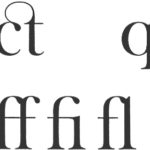doubt, critique, reason, hope
For everyone (like me) who keeps re-reading the 1992 edition of Robin Kinross’ Modern Typography: an essay in critical history… his revised edition (published in 2004) ends in an interestingly different way*:
“The phrase ‘democratization of typography’ has become common, referring to the wide availability of the tools of production for type and typographic design. One may take this with some skepticism: after all, for the majority, the generation and production of these tools is still largely in the hands of a few corporations — though the open source software movement may provide an alternative.
If democracy implies a spreading of power to the people, this is the wrong description of what is going on here: it is more a simple spreading of typography among the masses. The astonishing development in this period has not been the contribution of any designer or writer, but rather the spread of the means of making sophisticated typography to anyone with a computer. The domain of typography has been opened up, as never before, and there is a much wider interest in the activity now than there was even twenty years ago. (…) The great negative of the modern — irrevocable and disastrous damage to the natural world — gathers terrifying pace. Enlightenment thus proceeds, amid much babble and confusion. The watchwords remain: doubt, critique, reason, hope.”
(Robin Kinross in: Modern Typography: an essay in critical history. Hyphen Press, 2004)
Thank you Dave Crossland for the reminder 🙂
* 1992 ending: “The attempt of this essay has been to point to the effort of reason that has extended over centuries and which, in typography, has shown itself in a concern for fundamental issues: the means by which the processes of production can be controlled; the ways in which the needs and desires of readers and users can be incorporated into the shaping of products; the description and ordering of the activity and its materials. Reflection and discussion are the chief means by which this process has been effected: thus the ‘black art’ has been lifted from its dark, magical origins, into what is sometimes (though still too rarely) a forum of articulate practice and constructive criticism. There is some connection between this critical rationality and an approach to the production of artifacts and their eventual form. This connection will be left undefined here: it is open for discussion and exploration.“






1 Comment ↓
1. harrisson
Oct 13, 2008 at 8:04 pm
As I’m currently doing tours and visits the exhibition “Les plus beaux livres Suisses 2007” (very controversial) which happens this week in ERG Ecole de Recherche Graphique in Brussels, I noticied 2 interesting quotes from the interview of members of the jury, in the competition catalogue:
This one that I really don’t agree with, but which show the armless position of politics in graphic design today:
“To be active in the public domain pre-supposes that there are specific spaces provided for interaction and that the border between the private are clearly drawn. Such was maybe the case with modernism: if you were able to infiltrate into one of those institutions, you could speak from there and be heard. These “privilege” position don’t exist anymore. The semiotic geography of today is much more atomised. As you could witness in politics and philosophy recently, even if you have something to fight against, the question is on what ground can you fight back?”
Lionel Bovier, member of the jury.
And the desperate one that asks for a romantic fight:
“(…_ The contemporary perception of graphic dign is entirely superficial, to the point superficiality becomes a prerequisite for your professionnal success. There’s a lack of design criticism, it’s simply mot discussed in a serious way. And I deplore the absence of any sense of history. (…) And if the debate becomes heated then it’s a good sign because it shows that people still care.”
Cornel Windlin, president of the jury of this competition.
Ready to hear? Ok.
Ready to change? Hm…